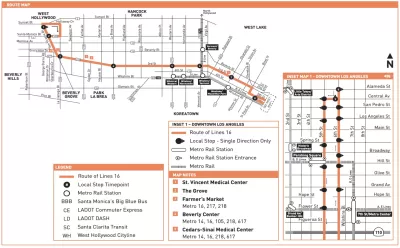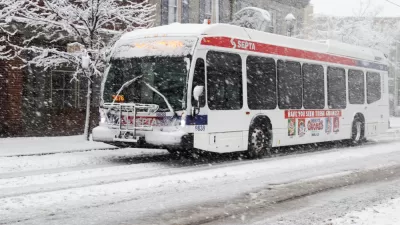Los Angeles’ 16 bus, which cuts across the city on Third Street through some of the city’s densest neighborhoods, will experiment with a new approach to service design.

The Los Angeles County Metropolitan Transportation Authority (Metro) bus system is switching to “headway-based operation” to improve performance along a popular east-west route. The Metro 16 bus will operate without a schedule between 7 am and 5 pm on weekdays.
According to an article by Daniel Martinez for LAist, headway-based operations differ from Metro’s standard timetable bus service design schedule by focusing on the spacing between buses (i.e., headways), rather than a set schedule of departure and arrivals.
Martinez also explains how headway-based operations work in an era of real-time location technology:
Thanks to advances in technology, supervisors will monitor the intervals at departure, in the middle of the line, and at the end of service. Additionally, bus operators will have tablet displays that provide real-time feedback on when their pacing is good, when to slow down to increase the gap between buses, and when to speed up to avoid bunching.
Headway based operations can thus mitigate bus bunching—when several buses can pass in quick succession, leaving a longer-than-planned gap between headways.
“Similar headway based programs had been tried in other large cities like Honolulu, Austin, and Seattle,” according to Martinez, but Metro scrapped its own previous attempt at headway-based operations with the launch of rapid service back in the early 2000s.
FULL STORY: Can Buses Run More Efficiently Without A Schedule? Metro Wants To Test It Out

Planetizen Federal Action Tracker
A weekly monitor of how Trump’s orders and actions are impacting planners and planning in America.

Maui's Vacation Rental Debate Turns Ugly
Verbal attacks, misinformation campaigns and fistfights plague a high-stakes debate to convert thousands of vacation rentals into long-term housing.

San Francisco Suspends Traffic Calming Amidst Record Deaths
Citing “a challenging fiscal landscape,” the city will cease the program on the heels of 42 traffic deaths, including 24 pedestrians.

Defunct Pittsburgh Power Plant to Become Residential Tower
A decommissioned steam heat plant will be redeveloped into almost 100 affordable housing units.

Trump Prompts Restructuring of Transportation Research Board in “Unprecedented Overreach”
The TRB has eliminated more than half of its committees including those focused on climate, equity, and cities.

Amtrak Rolls Out New Orleans to Alabama “Mardi Gras” Train
The new service will operate morning and evening departures between Mobile and New Orleans.
Urban Design for Planners 1: Software Tools
This six-course series explores essential urban design concepts using open source software and equips planners with the tools they need to participate fully in the urban design process.
Planning for Universal Design
Learn the tools for implementing Universal Design in planning regulations.
Heyer Gruel & Associates PA
JM Goldson LLC
Custer County Colorado
City of Camden Redevelopment Agency
City of Astoria
Transportation Research & Education Center (TREC) at Portland State University
Jefferson Parish Government
Camden Redevelopment Agency
City of Claremont





























